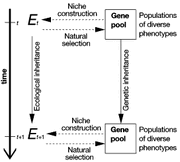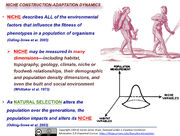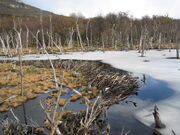
Explanation regarding the impact niche construction has on a population.
Niche Construction Theory
The process by which a species alters its own, or another species, environment in a way that may increase its chances for survival. Many argue that niche construction is as important to evolution as natural selection in that not does the environment cause changes to a species through selection but species can also cause changes to their environment through niche construction.
Niche construction creates a cyclical relationship between natural selection and niche construction because when organisms impact their environment, that change can cause a shift in what traits are being naturally selected for. The effects are especially pronounced in situations where alterations continue for many generations.
This theory, along with natural selection, indicate that organisms inherit two legacies from their ancestors: genes and a modified environment. Together, these two mechanisms determine a populations' fitness and determines what adaptations will be naturally selected for in an effort to continue survival.

lalandlab.st-andrews.ac.uk/niche/pdf/Publication152.pdf
anthropology.si.edu/archaeobio/images/CNC BT 2012.pdf
How a Niche is Manipulated[]
Niche construction is the process whereby organisms, through their metabolism, their activities, and their choices, modify their own and/or others' niches. For instance, numerous animals manufacture nests, burrows, holes, webs, and pupal cases; plants change levels of atmospheric gases and modify nutrient cycles; fungi and bacteria decompose organic matter; and bacteria fix nutrients. However, the defining characteristic of niche construction is not organism-driven modification of the environment, but rather modification of the organism's niche.

Results of a beaver dam on a niche
The most commonly thought of species to use niche construction is the beaver. In producing a lodge or damn the beaver not only increases its own chances of survival to reproduction and the survival of its offspring, but also changes the environment around it. With the construction of a dam, the beaver alters river flow, can create a lake, affects nutrient cycling, decomposition dynamics, the structure of the riparian zone, and plant and community composition and diversity.
ccf.nd.edu/assets/32272/fuentes.pdf
Another example of niche construction on a smaller scale, is through "leaf ties", created by various species of caterpillars. Caterpillar silk is used to attach an end of a leaf to a tie down point toward the cent of the leaf, or between overlapping leaves, to form a shelter to protect against predators and weather. This also attracts an arthropod community which relies on the manipulated leaves for colonization. Communities vary depending on the tree species and the season. Also, a higher abundance of biodiversity correlates with the presence of a caterpillar within the leaf tie.

Caterpillar forming leaf ties.
Sigmon, E.& Lill, J.(2013). Phenological variation in the composition of a temperate forest leaf tie community. Environmental Entomology, 42(1): 29-37.
http://entomology.umd.edu/research/fall2013colloquium/elishasigmon